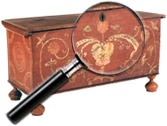Stereoscope or Stereo Viewer
In 1832 British scientist Sir Charles Wheatstone invented a viewing device incorporating angled mirrors that became known as the “Wheatstone Stereoscope”. In 1838 he published a paper entitled Contributions to the Physiology of Vision on Some Remarkable and Hitherto Unobserved Phenomena of Binocular Vision. The basic theory of the paper stated that the human eye perceives objects in three dimensions because each eye sees things from a slightly different perspective. Wheatstone came up with the word Stereograph to explain this and it comes from the Greek stereo meaning solid and graph meaning to a look at. Prior to the invention of photography this instrument was used to view pairs of drawings.
The next significant development in stereoscopic viewers came in 1851 when another British inventor, Sir David Brewster, introduced a new type of stereoscope at the International Exhibition at the Crystal Palace in London. This viewer became known as simply the “Brewster Stereoscope”. Queen Victoria was impressed by stereo photography and her patronage helped launch its popularity. Vast numbers of these new viewers were sold, fuelling the demand for the stereo views themselves.
In 1854 two brothers, William and Frederick Langenheim, whose photographic studio was based in Philadelphia, introduced the stereo format to the American public. They produced a simple box-like viewer. Dr. Oliver Wendell Holmes recognized the need for a less expensive viewer. He approached various businessmen with his basic idea. Joseph L. Bates of Boston took an interest and improved on Holmes’s initial design. Production soon began on the now familiar Holmes-Bates stereoscope. This new inexpensive design was eagerly embraced by the public and became the first mass-market stereoscope. By the end of the 19th century, virtually every middle class home in the U.S. had a stereo viewer and a group of views. Much the same as a television today, the stereo view brought the outside world into the home allowing a person to see a three dimensional images of exotic places around the world. Early in the 20th century stereo views were widely used in schools as an educational tool.
The popularity of the Brewster stereoscope and the Holmes-Bates stereoscope led other manufacturers to produce their own versions. These range from very simple designs to highly elaborate and decorative table-top and parlor models.
Another type of viewer was the stereographascope, patented in Great Britain in 1864 by Charles John Rowsell, based on the already existing graphascope which incorporated a large magnifying lens. This instrument was used to view cartes de visites in greater detail. Rowsell improved on the original design by adding a pair of stereoscopic lenses to the graphascope. This enabled the viewing of two different formats in one device. As with stereoscopes, numerous designs followed in great number.
As a guide the market value is based on the maker, rarity and condition of the viewer. In some cases a rare viewer in poor condition will still command a higher price, but condition is a key factor in pricing. Viewers can range in price from under $50 for a very basic example to many thousands for a rare or desirable viewer in excellent condition.
Reference note by p4A Contributing Editor Robert M. Ginns.
